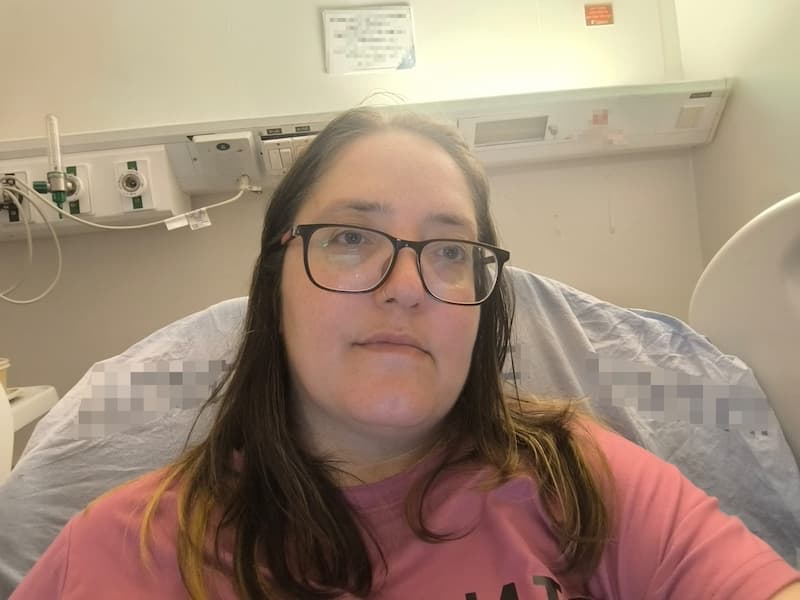
Universe, I know I said I desperately needed a break from my kids — and yes, the last time I felt that way, even five days alone with COVID in an Airbnb somehow did the trick. But just to clarify: I wasn’t asking to be hospitalized for a few days as my “break” this time! I have my trip to Malta planned already and I plan on making that flight in 6 days.
So why am I in the hospital?
Note, there will be a little TMI in this post, but not too bad.
I guess it starts back a few years ago, in August 2020, when out of the blue, I suddenly became extremely, extremely exhausted all the time. I went from needing a normal amount of sleep to needing over 12–13 hours just to feel rested. On top of that, I started feeling ridiculously hot all the time—dripping sweat profusely, even in temperatures that others found perfectly comfortable. I also began experiencing severe fatigue after any exertion; I’d go to the city one day and need another day or two to recover.
Nothing had changed. My medication hadn’t changed. My weight hadn’t changed. The only explanation I could think of—since this was a few months into the pandemic—was that maybe I’d had Covid without realizing it, and these were long Covid symptoms. But when I tested for antibodies, the results came back negative.
I started undergoing all sorts of testing. I went to an endocrinologist to check things out. But I was hypothyroid, which wouldn’t explain the heat intolerance—if anything, hyperthyroidism would, which is the opposite of what I had. And since my thyroid levels were balanced with medication, it didn’t seem to explain the exhaustion either.,
The endocrinologist even tested me for something quite rare — a pheochromocytoma, a non-cancerous adrenal tumor that can cause symptoms like mine. It was a hassle to get tested, but that, too, came back negative. Still a mystery.
Then, a little over a year ago, I started experiencing tinnitus — but only in certain positions. It first showed up when I was on the toilet doing a Valsalva maneuver. The sound was so irritating that I actually started dreading bathroom trips.
Eventually, the whooshing sound started happening when I bent forward.
Then when I lay down.
Not all the time, but often enough.
Whoosh, whoosh, whoosh.
In my left ear.
A pulsing waterfall.
I went to an ENT, but he wouldn’t diagnose me with tinnitus without a hearing test. I waited a few months for the test, which came back normal. I returned to the ENT, who ran more tests and referred me to a neurologist. The neurologist ran their own round of tests, and when those also came back normal, I was referred to a tinnitus specialist at a nearby hospital.
While the tinnitus was annoying, it wasn’t the only reason I kept pushing for answers. I knew that pulsatile tinnitus, in particular, could be a sign of something more serious. And it turns out — it was.
In the meantime, I started getting headaches. I assumed they were from dehydration (even though I thought I’d drunk enough), especially because they’d wake me in the middle of the night and go away after I was upright and had some water. That seemed to support the dehydration theory, so I didn’t think too much of it.
Then I saw the tinnitus specialist — the most patient, methodical doctor I’d ever encountered. He was an 85-year-old neurologist, and it was the second-longest doctor’s appointment I’ve ever had. After a long intake and a detailed physical exam, he asked me if I’d been experiencing headaches. I told him yes.
That’s when he told me he suspected I had idiopathic intracranial hypertension, also known as pseudotumor cerebri — a condition where your body produces too much cerebrospinal fluid, leading to increased pressure inside the skull. That pressure can cause a variety of symptoms. You don’t have to have all of them, but in my case, I had the most classic:
- Headaches that get worse when lying down
- Pulsatile tinnitus triggered by lying down, bending forward, or Valsalva maneuvers
- Neck pain
- Exhaustion
- Dizziness
- Heat intolerance (less classic but still common)
There are also vision issues it can cause by putting pressure on the optic nerve, but a recent eye exam I had showed that, at least then, it wasn’t an issue.
It is more likely to show up in females in my age range, and more likely to occur in fat people like myself.
The doctor referred me for a CTV—a CT scan of the veins in my head. It isn’t a definitive way to diagnose IIH, but it can rule out other causes of increased pressure and sometimes show indirect signs that support an IIH diagnosis.
Before sending me for the scan, though, the doctor asked me to try something: press on my jugular vein to see if the tinnitus stopped. If it did, that would suggest IIH as the likely cause. And… it did. Ding ding ding.
Apparently, IIH is a common comorbidity of EDS as well. It’s still an area being actively researched, so the connection isn’t fully understood yet, but there’s something there.
I was a bit worried that the CTV wouldn’t pick anything up clearly since my symptoms come and go. But—luckily or unluckily—four days ago, the day before the scan, I developed one of those headaches… and this one didn’t go away. That night, it kept me up for hours. In the morning I had to fast for the scan, and afterward, even though I was hungry, I had no appetite. (That’s not typical for me unless I’m very depressed—but emotionally, I was fine.) They told me the CTV results would take a few weeks.
The headache kept me up again the next night, and it was still going strong the next morning. I still had no appetite despite feeling hungry. I was exhausted, but lying down made it worse, and I started feeling the headache behind my eyes.
Since IIH-related headaches that come with vision changes or nausea need to be evaluated quickly, I called my insurance’s on-call doctor. He gave me a referral and told me to head to the ER. I figured they’d be able to read the CTV right away, confirm if it was IIH, and start treatment if necessary.
I packed a bag, since it was already evening and I figured there was a good chance I’d be staying the night, and headed to the hospital. The doctor listened to my concerns about possible IIH, asked if I knew how it’s diagnosed, and I told him I did—that the confirmation comes through a spinal tap, and that I had already had a CTV done. He told me to submit the scan to the radiology department for review. After a neurological exam (which was normal), he informed me that no radiologist would be available to read the CTV until the morning. I’d need to stay overnight in the ER for further evaluation, including an eye exam and another neurological check in the morning. I asked if I could just go home and come back in the morning, but he said I couldn’t.
The next morning, the neurological and eye exams fortunately came back normal. The doctor said I’d likely be discharged in time to make my 1 p.m. therapy appointment—just waiting on final paperwork. But then he mentioned that the CTV did show something notable: an empty sella, which is a sign sometimes seen in IIH. It means the pituitary gland isn’t clearly visible in the sella turcica (the small cavity in the skull where it usually sits), either because it is deformed, or because it’s been flattened or displaced due to increased intracranial pressure.
He recommended that I schedule a follow-up with a neurologist and an eye doctor in a week. When I told him I’d be abroad then, he said that two weeks would also be fine.
So I told people I was getting released.
Then the nurse came over and told me to cancel my therapy appointment — they had decided to do a lumbar puncture (LP). He applied numbing cream to my back to start prepping me for it.
A little later, the head neurologist walked in. He said he just happened to be nearby, so I got lucky — he would be the one doing the procedure. He asked if I knew what to expect. I told him I had read a lot: it was supposed to be more pressure than pain, shouldn’t be too bad, etc. I lay on my side and curled up, and as he began palpating my spine, just his touch already hurt. (Looking back, that should’ve been a red flag. More on that in a bit.)
From everything I’d read, the pain was supposed to be minimal — maybe a second or two — and mostly just pressure. So I braced myself. But when the needle went in, it really hurt. Then he pulled it out and I asked, “You’re done?”
“No,” he said. “The needle was the wrong size. I have to do it again.”
Oh. My. God.
He tried again. This time, knowing how much it hurt the first time, I stayed as still as humanly possible — any movement could cause complications. And it was, without exaggeration, the most painful thing I’d ever experienced. I held back screams, bit my tongue to keep from cursing out loud. Just when I thought I couldn’t take it anymore, he asked, “Does it hurt?”
I was like — What the hell? Of course it hurts!
And then he told me he had only reached bone, not the cerebrospinal fluid. He couldn’t get the sample.
So after going through all that pain and suffering, it was for nothing.
“So you’re not going to do it in the end?” I asked them.
He told me he’d do it again, but first sedate me. They gave me a strong benzodiazepine and oxygen, and fortunately this time they were able to complete the procedure, and I didn’t really feel the pain.
However, what I did feel was the sensation as if I peed myself out my back, with warm cerebrospinal fluid flowing out quickly and then dribbling down my back and onto the bed. Yes, that fluid was due to my intracranial hypertension, where the pressure in my cerebrospinal fluid was elevated — around 29 or 30 cmH₂O, while normal pressure is typically up to 25 cmH₂O.
After that, I lay on my side for two hours before I was allowed to get up. Then they gave me an IV of caffeine to help with the headache. I made a joke about why anyone would need to drink caffeine when they could just get it directly into their veins, but honestly, the caffeine in my veins felt like fire spreading through them.
I think the reason the LP was so incredibly painful for me was because of my EDS. I don’t actually have a low pain tolerance. Most of my daily EDS pain is between a 4 and a 7, rarely reaching an 8. The only exception is when my physical therapist is working on specific areas—then the pain can climb to a 9 or even a 9.5, and all I can do is choke back screams. (She really knows how to make me suffer, but I love her because I know the work she does is effective, even if it feels torturous.) One area she focuses on is my spine. My vertebrae sublux frequently, and some end up pressing against each other. To move them apart, she has to press on the space between them, which is the most excruciating part and the reason I scream.
When the neurologist began pressing on my vertebrae before starting the LP, the pain immediately shot up to an 8 or 9. So, combining that excruciating spinal pain with the added discomfort of the lumbar puncture was probably what pushed it over the edge.
After the LP, I was told I’d be admitted to the hospital for a few days to try to manage the IIH. The admitting doctor proudly told the nurse that he had figured out it was IIH and had decided to perform the LP. But when the nurse found out I’d already suspected IIH based on advice from my personal neurologist, she seemed a little miffed that he was acting like the diagnosis was entirely his discovery.
That evening, I was moved up to the ward.
By the time I’m finishing writing this, it’s already been 24 hours since I got to my room in the ward—and nearly 48 hours since I first arrived at the ER. They started me this morning on medication to reduce my cerebrospinal fluid production, but so far, it hasn’t helped with the headache.
It looks like I’ll be here over the weekend, not just for a day or two as initially expected.
Last night, a friend brought me a few things from home—my full-body pillow (well, the old smaller one, since the newer one was too big to bring), some clothes, medication, and food. Today, my dad and stepmom visited with even more goodies.
During morning rounds, I told the neurologist that if I’m not discharged by Sunday, I’ll be checking out against medical advice—I have a trip to Malta on Tuesday, and he understood the urgency.
So here I am. Since there’s not much else to do, I’m spending a lot of time on my computer and phone, and hopefully I’ll have more updates to share soon.
I’m sure I’ll be posting more about this IIH journey as I learn how to manage it. One of the recommended ways to manage IIH is weight loss—even a few pounds can make a difference—and since I’ve recently started doing cardio at the gym, I’m hopeful it’ll help.
This is the first time I personally am hospitalized other than after my first two childbirths. I was hospitalized with my 3 older kids as babies in this same hospital, so I know my way around it.
Emotionally, I’m doing totally fine being here. Honestly, I feel validated—like they’re finally taking my symptoms seriously. It’s a relief to have a diagnosis and to be getting treatment, especially since my next scheduled neurology appointment wasn’t for another month and a half. The head pain isn’t worse than what I was already living with at home. I came to the hospital when I did because I knew I was flying to Malta the following Tuesday and wanted to get help ahead of time—not end up in the ER last minute and miss my trip. I also wanted to make sure the pressure wasn’t damaging my optic nerves.
Balancing IIH treatment with POTS is going to be tricky, since some treatments contradict each other, but my neurologist is well aware of POTS—his granddaughter has it—so I feel like I’m in good hands.
And finally, to the commenter who suggests a carnivore diet every time I mention a health issue: I appreciate your concern, but that’s not something that fits my life. Repeating it like a broken record isn’t going to change that.
Have you ever had a lumbar puncture? How painful was it for you? What was the most painful thing you, personally, have ever experienced?
Have you ever head of IIH? If you have it, how do you treat it?
When was the last time you were hospitalized? Any tips and tricks?





2 Responses
Oh, my. This is complicated, but at least they have a game plan. Prayers…
Wishing you a speedy recovery! Just check about insurance coverage if you leave against medical advice… someone told me once, during my son’s long hospital stay, that the national health insurance might refuse to cover the whole visit if leave against medical advice. I didn’t confirm if that is true. Feel better soon, and glad you are getting cared for and getting to the root of the problem!